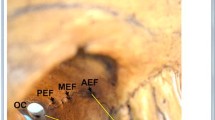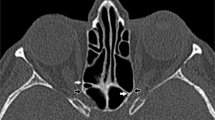Abstract
Purpose
In addition to the optic canal and the superior orbital fissure, orbits are connected with the cranial cavity via inconstant canals including the orbitomeningeal foramen. This study has been carried out in order to define many anatomical and radiological details of the orbitomeningeal foramen that are relevant in the clinical practice.
Methods
Almost 1000 skulls and 50 computerized tomographies were examined to determine incidence, number, length, and caliber of the orbitomeningeal foramen as well as the topography of their orbital and cranial openings. A retrospective study of angiographies carried out on more than 100 children was performed to look for arteries candidate to run through the orbitomeningeal foramen.
Results
Orbitomeningeal foramina were detected in 59.46 % of skulls and in 54 % of individuals by computerized tomography. Orbits with two to five foramina were found. Canals were classified as M-subtype or A-subtype depending on their cranial opening. Large foramina, with the caliber ranging between 1 and 3 mm, were found in 12.17 % of orbitomeningeal foramen-bearing orbits. By computed tomography the average caliber measured 1.2 ± 0.3 and 1.5 ± 0.5 mm (p < 0.005) at the orbital and cranial openings, respectively (p < 0.005). Angiographies showed meningo-lacrimal and meningo-ophthalmic arteries, meningeal branches of the lacrimal and supraorbital arteries, and some unidentified arteries that could pass through the orbitomeningeal foramina.
Conclusions
Orbitomeningeal foramina are a common occurrence. When large they may house important arteries that can be the source of severe bleedings during deep dissection of the lateral wall of the orbit. Orbital surgeons should be aware of their existence.









Similar content being viewed by others
References
Bertelli E (2014) Metoptic canal, duplication of the optic canal and Warwick’s foramen in human orbits. Anat Sci Int 89:34–45
Bertelli E, Regoli M (2014) Branching of the foramen rotundum. A rare variation of the sphenoid. Ital J Anat Embryol 119:148–152
Kier EL (1966) Embryology of the normal optic canal and its anomalies: an anatomic and roentgenographic study. Invest Radiol 1:346–362
Celik S, Kazak Z, Ozer MA, Govsa F (2014) Navigational area of the cranio-orbital foramen and its significance in orbital surgery. Surg Radiol Anat 36:981–988
Erturk M, Kayalioglu G, Govsa F, Varol T, Ozgur T (2005) The cranio-orbital foramen, the groove on the lateral wall of the human orbit, and the orbital branch of the middle meningeal artery. Clin Anat 18:10–14
Georgiou C, Cassell MD (1992) The foramen meningo-orbitale and its relationship to the development of the ophthalmic artery. J Anat 180:119–125
Bergman RA (2015) Anatomy atlases. http://www.anatomyatlases.org/AnatomicVariants/AnatomyHP.shtml
McQueen CT, DiRuggiero DC, Campbell JP, Shockley WW (1995) Orbital osteology: a study of the surgical landmarks. Laryngoscope 105:783–788
Singh P, Raibagkar CJ (2011) Study of variation in atypical foramina of dry human skull. Natl J Integr Res Med 2:1–5
Abed SF, Shams P, Shen S, Adds PJ, Uddin JM, Manisali M (2012) A cadaveric study of the cranio-orbital foramen and its significance in orbital surgery. Plast Reconstr Surg 129:307e–311e
Sepahdari AR, Mong S (2013) Skull base CT: normative values for size and symmetry of the facial nerve canal, foramen ovale, pterygoid canal, and foramen rotundum. Surg Radiol Anat 35:19–24
Ginat DT, Ellika SK, Corrigan J (2013) Multi-detector-row computed tomography imaging of variant skull base foramina. J Comput Assist Tomogr 37:481–485
Macchi V, Porzionato A, Morra A, De Caro R (2014) Gabriel Falloppius (1523–1562) and the facial canal. Clin Anat 27:4–9
Bracco S, Venturi C, Leonini S, Romano DG, Cioni S, Vallone IM, Gennari P, Galluzzi P, Hadjistilianou T, De Francesco S, Guglielmucci D, Tarantino F, Bertelli E (2015) Identification of intraorbital arteries in pediatric age by high resolution superselective angiography. Orbit. doi:10.3109/01676830.2015.1049368
Arai H, Sato K, Katsuta T, Rhoton AL Jr (1996) Lateral approach to intraorbital lesions: anatomic and surgical considerations. Neurosurgery 39:1157–1162
Martins C, Costa e Silva IE, Campero A, Yasuda A, Aguiar LR, Tatagiba M, Rhoton A Jr (2011) Microsurgical anatomy of the orbit: the rule of seven. Anat Res Int. doi:10.1155/2011/468727
Natori Y, Rhoton AL (1994) Transcranial approach to the orbit: microsurgical anatomy. J Neurosurg 81:78–86
Lyson T, Sieskiewicz A, Rogowski M, Mariak Z (2015) The transmaxillary endoscopic approach to the inferior part of the orbit: How I do it. Acta Neurochir
Karaki M, Kobayashi R, Mori N (2006) Removal of an orbital apex hemangioma using an endoscopic transethmoidal approach: technical note. Neurosurgery 59(1 Suppl 1):ONSE159–ONSE160
Diamond MK (1991) Homologies of the meningo-orbital arteries of humans: a reappraisal. J Anat 178:223–241
Lasjaunias P, Michotey P, Vignaud J, Clay C (1975) II- Radioanatomie de la vascularisation artérielle de l’orbite, a l’exception du tronc de l’artére ophthalmique. Ann Radiol 18:181–194
Moret J, Lasjaunias P, Théron J, Merland JJ (1977) The middle meningeal artery. Its contribution to the vascularization of the orbit. J Neuroradiol 4:225–248
Uchino A, Saito N, Takahashi M, Kozawa E, Mizukoshi W, Nakajima R, Okano N (2013) Persistent dorsal ophthalmic artery and ophthalmic artery arising from the middle meningeal artery diagnosed by MR angiography at 3D. Surg Radiol Anat 35:775–782
Erdogmus S, Govsa F (2005) Importance of the anatomic features of the lacrimal artery for orbital approaches. J Craniofac Surg 16:957–964
O’Brien A, McDonald SW (2007) The meningo-orbital foramen in a scottish population. Clin Anat 20:880–885
Jadhav SD, Roy PP, Ambali MP, Patil RJ, Doshi MA, Desai R (2012) The foramen meningo-orbital in indian dry skulls. Natl J Integr Res Med 3:46–49
Rontal E, Rontal M, Guilford FT (1979) Surgical anatomy of the orbit. Ann Otol Rhinol Laryngol 88:382–386
Saba L (2013) Computed tomography of carotid and vertebral arteries. In: Saba L, Suri JS (eds) Multi-detector CT imaging: principles, head, neck, and vascular systems. CRC Press, London, pp 383–384
Macchi V, Porzionato A, Morra A, D’Antoni AV, Tubbs RS, De Caro R (2014) Anatomico-radiologic study of the distribution of the suboccipital artery of Salmon. Clin Neurol Neurosurg 117:80–85
Macchi V, Tiengo C, Porzionato A, Busetto L, Morra A, Martini R, Bassetto F, De Caro R (2014) Anatomical remodelling of the anterior abdominal wall arteries in obesity. Clin Hemorheol Microcirc 57:255–265
Acknowledgments
The authors are grateful to Dr. Gianpaolo Mornata and Dr. Gloria Sarasin for their skillful technical assistance and to Radiologic Center Euganea Medica.
Author information
Authors and Affiliations
Corresponding author
Ethics declarations
Conflict of interest
The authors declare that they have no conflict of interest.
Additional information
Veronica Macchi and Marì Regoli have contributed equally to this work.
Electronic supplementary material
Below is the link to the electronic supplementary material.
Rights and permissions
About this article
Cite this article
Macchi, V., Regoli, M., Bracco, S. et al. Clinical anatomy of the orbitomeningeal foramina: variational anatomy of the canals connecting the orbit with the cranial cavity. Surg Radiol Anat 38, 165–177 (2016). https://doi.org/10.1007/s00276-015-1530-8
Received:
Accepted:
Published:
Issue Date:
DOI: https://doi.org/10.1007/s00276-015-1530-8




